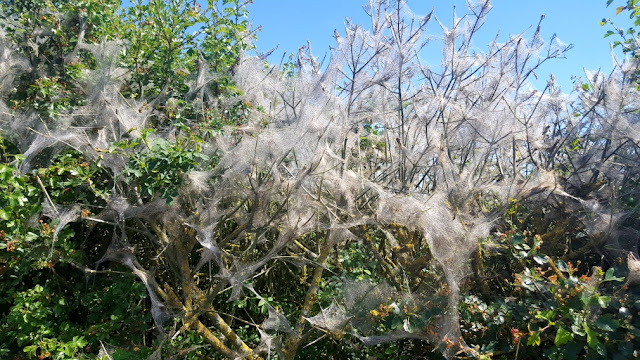Last Wednesday (depending on when you are reading this) I headed north-east from home en route to Whitstable. I had local sleuth Miss Marple with me in the car, and as we traversed the highway towards Smarden Bell, she called my attention to a hedgerow full of cobwebs.
Without taking my eyes off the road ahead, I couldn't really get a look, but thought it strange that spider webs would be so obvious in bright sunshine. I mentioned this to 'Jane' and made a mental note to take a better look on the way home. I had my suspicions as to what these webs might actually be.
And so it was that a few hours later, frazzled by one of the hottest days of the year thus far, and miffed at losing my hat somewhere in town, we re-located the hedge in question, and I pulled over to investigate: Miss Marple realising that no crime had been committed, remained in the vehicle a deal less interested than I.
Here's the overview..
I can see why Miss Marple would think this is the work of a spider; after all, it's not her field of expertise. Plus, she's only fictional!
Getting a little more forensic with the camera revealed this...
As I had suspected, not Arachnid at all, but Lepidoptera. This is the feeding web of Ermine moth caterpillars. They feed in large groups, and as they move around the plant eating its leaves, they each produce silk. Collectively, this quickly creates the large silken webs as shown in my photographs.
The web offers a degree of protection from predators.
Being that the plant is Hawthorn, these are most likely to be Orchard Ermine (Yponomeuta padella).
Staying with Lepidoptera for a moment; when I first saw this moth, it looked to me like somebody had 'doodled' on its back...
I'm not sure that since the invention of the mobile phone people even doodle anymore, do they? You don't sit at a desk with a note pad and take calls anymore - you walk along the street with an earpiece, talking to an invisible person and annoying all and sundry, don't you? Making a spectacle of yourself!
Oh look...almost like I planned it; this moth (for obvious reasons) is called the Spectacle...
A couple more moths to share, and then we can move on...
The first photo is of a Buff-tip moth, and the lower one is a Puss moth.
Which came first? The moth, or the moth egg? What we can know is that the egg produces the larvae: like this one for instance...
 |
| The Sprawler - Asteroscopus sphinx |
This one is the larva of the Sprawler moth. The adult moth is not particularly exotic in appearance. But the larva has this peculiar habit of throwing its head back in a defensive manner, which is where the common name comes from.
Enough with the moths JJ!
Okay, okay. I heareth thee. How about a very smart looking Cicadellidae...
This is Oncopsis species, but these are notoriously difficult to separate. It could be O.flavicollis, and that's my guess. But might well prove to be one of the others.
------------------------------------------------
I have been finding yet more Brassica shieldbugs in my local woods. Perhaps 2021 is going to be a good year for them after several barren ones...
A couple of cool moths from the garden next: first is Angle Shades and below that a Cinnabar moth.
Did you know that Cinnabar is an element? A form of Mercury. Oh! You did, okay.
I bet you didn't know that the Angle Shades moth was previously named the 'Burned-edge Fulvous moth' though? Derived from the back edge of the wings looking like burned paper.
I thought not! In fairness, it doesn't surprise me that you had no knowledge of this fact, because I just made it all up!
BUGS are, or seem to be in short supply once again this year. I cannot recall a good year recently in fact. Very few nymphs so far, and only a couple of adults. The top photo here is of a brand-new Dock bug nymph 'Coreus marginatus'; The next is a 'Rhabdomiris striatellus' nymph (Mirid Bug), and the final one....isn't!
Oh, you want to know what the adult bug is? Well I think it is 'Closterotomus fulvomaculatus' if that helps? Basically, it's a plant bug!
I think...and I stress think, that the top two photos above are of a female 'Helophilus affinis', but as always, please do correct me if I have got it wrong.
The bottom image is a female 'Xylota segnis'. Also correct me if this is wrong, blah-de-blah, de-blah....
Edit: This is female X. sylvarum (thanks to Tim Ransom for correction).
Alright then, in the words of Trevor Macdonald..."And finally..."
Cuckoo spit!
There is no such thing as cuckoo spit as we all know. There is something people like to refer to as that, but it's not produced by a cuckoo, and comes from the orifice at the other end of the body to that which produces spit. It's the work of the common Froghopper, and I caught this one in my garden just winding up the spit machine to full throttle.
The best and most beautiful things in the world cannot be seen or even touched - they must be felt with the heart.
Helen Keller



















No comments:
Post a Comment